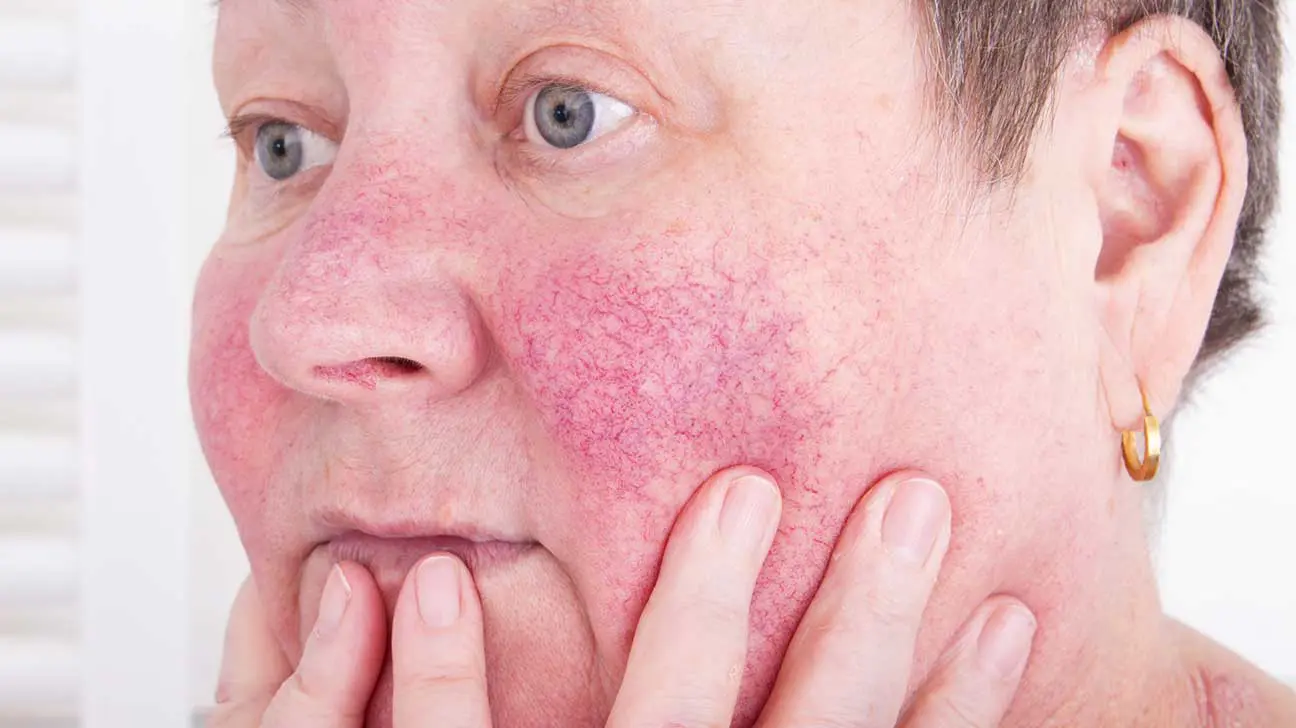What Is An Alcoholic Nose Or Rhinophyma? | Symptoms, Causes, Treatment
For many years, it was assumed that rhinophyma (a misshapen, red, bulbous nose skin condition) was the result of alcoholism. However, recent studies have found a different perspective.

Rhinophyma has been given several misleading names over the years, including “alcohol nose,” “alcoholic nose,” “drinkers nose,” “brandy nose,” and “bulbous nose.” While the nicknames suggest that rhinophyma is caused by alcohol consumption, research is showing that may not be the case.
Rhinophyma is actually a subtype of rosacea, a skin disorder that leaves the nose looking swollen, enlarged, red, bulbous, and distorted. People who experience Rhinophyma may also experience other types of rosacea.
Is Rhinophyma Caused By Alcoholism?
Rhinophyma is not directly caused by alcoholism or regular alcohol consumption. This previously assumed connection was made since alcohol has been known to have a negative effect on the vascular system, enlarging vessels in the face and neck, causing reddening or flushness.
However, after research has shown that just as many individuals who do not drink are diagnosed with rhinophyma as those that do drink alcohol, the numbers do not support alcohol causing rhinophyma.
Causes Of Rhinophyma Or Alcoholic Nose
While the previous belief was that rhinophyma was the result of alcohol consumption, there is no factual link between alcohol and rhinophyma. However, drinking alcohol and consuming caffeine can dilate blood vessels, which can aggravate existing rhinophyma.
Over the past decade, research has discovered factors that seem to put a person more at risk for developing rhinophyma:
- family history of rosacea
- being middle-aged
- being male
- having fair skin
Some evidence shows that a person can be genetically predisposed to rhinophyma, as it runs in families of Scandinavian, English, Scottish, and Eastern European descent.
The exact cause of rhinophyma remains unknown. However, it is believed that rhinophyma is one of the worst forms of rosacea, and is the result of not treating a milder form of rosacea early on.
Symptoms Of Rhinophyma
When a person is concerned they may have rhinophyma, or any other form of rosacea, a doctor can usually diagnose this condition by observing the patient’s face.
In cases of rhinophyma, the symptoms may include:
- visible blood vessels
- enlarged pores
- scarring or pitting of the skin
- tip of the nose is red
- bulbous misshapen nose
- inflamed bumps or pimples
- red or purplish discoloration on the nose or along the cheeks
- thickened rough, waxy skin
If these symptoms are present, a doctor may suggest antibiotics, or another form of treatment to try to alleviate the irritation on the skin. Left untreated rhinophyma can cause excessive scar tissue to form, and surgery may be necessary.
Triggers Of Rhinophyma And Rosacea
While it may not be clear what causes rhinophyma, there are a number of triggers that can cause a flare-up of rhinophyma to occur.
Some of the more common triggers may be:
- heavy exercise
- sun exposure
- caffeine
- stress
- wind
- capsaicin (an ingredient in some hot peppers)
- spices
Avoiding these triggers may help keep the scarring caused by rhinophyma at bay, and doctors may choose to treat rosacea and rhinophyma with anti-inflammatories and topical antibiotics.
Rhinophyma, Rosacea, And Alcohol Consumption
While alcohol is not the cause of rhinophyma or rosacea, alcohol can have an impact on both. When a person has a pre-existing issue with rosacea or rhinophyma, it can irritate the disorder and worsen symptoms.
Surveys were taken from individuals diagnosed with either rhinophyma or rosacea, and the following suggestions were made for others with the disorder:
- do not drink red wine
- drink in moderation
- dilute alcohol with seltzer
- have water in between beverages
- do not cook with alcohol
Overall, doctors strongly encourage individuals with rosacea or rhinophyma to avoid alcohol altogether, and if they are not able to avoid alcohol, only drink very sparingly.
It may be encouraging to know that approximately 90 percent of individuals with rosacea reported that limited alcohol intake helped to significantly decrease sudden outbreaks.
Stigma Associated With Alcoholic Nose
Even though research is debunking the connection between alcoholism and rhinophyma, there is still a stigma attached to this disorder. It can be difficult for people with rhinophyma to go out in public due to the judgment they receive from others based on the appearance of their nose.
All too often, the stigma of alcoholism and addiction leads to discrimination, avoidance, and rejection of people struggling with this disease.
Whether a person is dealing with rhinophyma or alcoholism, it should not be acceptable to alienate a person or group of people due to a disease. There are several million individuals who attempt to manage their addiction every day, and less than eight percent actually seek treatment.
Removing Addiction Stigma
The stigma associated with the disease of alcohol and drug addiction can hurt a person’s chances of recovery by discouraging them from seeking help.
In order to dismantle the stigma connected to addiction, people can start by:
- recognizing actual (factual) warning signs of alcoholism
- having conversations with others about the realities of drug and alcohol addiction
- learning about substance abuse and addiction
- speaking out against discrimination towards individuals with addictions
- being compassionate towards those struggling with addiction
- eliminating words like “addict”, “junkie”, or “drunk” from the vocabulary
Seeking Treatment For Addiction
Addiction treatment is available for those who are struggling with alcohol abuse or addiction. Specially trained staff are available right now to discuss treatment options for you or your loved one. We can help find a detox or treatment program that will help get the services needed on the road to recovery.
Contact our helpline today to learn more about our recovery programs, to receive help with understanding your health insurance, and more.
- Clinical, Cosmetic and Investigational Dermatology—Rhinophyma: Prevalence, Severity, Impact and Management https://www.ncbi.nlm.nih.gov/pmc/articles/PMC7429105/
- European Annals of Otorhinolaryngology, Head and Neck Diseases—Rhinophyma: Our experience based on a series of 12 cases https://www.sciencedirect.com/science/article/pii/S187972961730128X
- Journal of Plastic Surgery —Rhinophyma https://www.ncbi.nlm.nih.gov/pmc/articles/PMC4426765/
- Plastic and Reconstructive Surgery—Rhinophyma: Dispelling the Myths https://journals.lww.com/plasreconsurg/Abstract/2004/08000/Rhinophyma__Dispelling_the_Myths.8.aspx


